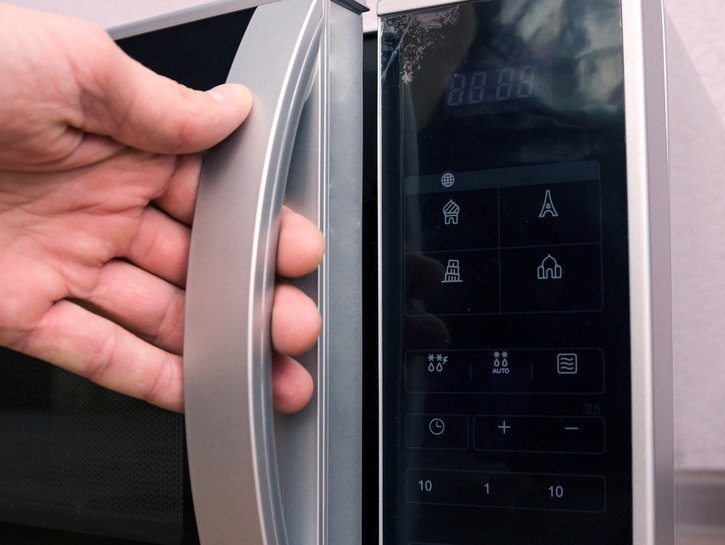There is one time-saving cooking appliance that can be found on most kitchen countertops. The microwave is favored by many Americans and can be found in 90 percent of American homes. Its ease of use and speed make it an enticing alternative to conventional heating methods. Although your microwave may provide lightning-speed cooking, steaming, and reheating, it’s not the best choice for every food.
Here are nine foods you shouldn’t microwave:
1. Chicken

Unlike other heating devices, microwaves tend to heat dishes unevenly, which opens the door to health hazards. Since microwaves can’t heat items evenly, certain bacteria can survive, including salmonella, which commonly contaminates chicken.
The Centers for Disease Control and Prevention in Atlanta conducted a study in 1992 to test the theory that bacteria is more likely to survive on microwaved raw meat than meat cooked using traditional heating methods. In the study, 30 participants reheated raw meat. The 10 who used a microwave became ill, but the 20 who used a skillet did not. This indicated that a microwave may not be the best choice for preparing chicken.
2. Rice

Uncooked rice can contain a bacteria called Bacillus cereus, which can cause symptoms of food poisoning. Cooked rice can still carry traces of this bacteria. Reheating rice will not eliminate the bacteria, so you can skip the microwave on this one. Since the spores of bacteria multiply on cooked rice if the rice is left standing at room temperature, it’s imperative to serve your cooked rice as soon as possible and to consume it in one sitting. If you’re unable to enjoy your rice right away, place the cooked rice in the refrigerator immediately to avoid the growth of bacteria.
3. Processed Meat

Processed meat, such as deli meat and hot dogs, contain numerous chemicals and preservatives that prolong their shelf lives. Microwave radiation has an adverse effect on these chemicals and contributes to the development of cholesterol oxidation products. Cholesterol oxidation products have been shown to be directly related to the development of coronary heart disease.
4. Hard-Boiled Eggs

Have you ever thought about reheating a hard-boiled egg in your microwave? What could possibly go wrong? Well, hard-boiled eggs have a tendency to explode after being microwaved. When a hard-boiled egg is microwaved, steam builds up under the egg’s yolk membrane. The steam builds up faster than it can escape, causing the egg to explode. Avoid this heating method and go a different route.
5. Hot Peppers

Putting a hot pepper in the microwave will result in an extremely spicy situation — it might even set off your fire alarms! Capsaicin, the chemical responsible for the heat intensity of the pepper, will be released while the pepper is microwaved, possibly causing the pepper to catch fire. When you open the microwave, the scorched pepper will emit irritants into the air that cause your eyes and throat to sting. Ouch!
6. Potatoes

Potatoes may contain Clostridium botulinum. Clostridium botulinum has the ability to develop heat-resistant spores that can survive normal cooking temperatures. If the bacteria are given a chance to grow given the right environment, they will produce botulinum toxin, which causes food poisoning symptoms.
Leftover potatoes invite the growth of Clostridium botulinum. It’s essential to reheat them properly so that they don’t develop botulinum toxin. Forgo the microwave and cook your spuds in the oven instead, due to the uneven cooking that can take place in microwaves.
7. Leafy Greens

Those leafy greens are essential for a balanced diet, so it’s best not to waste them, but it’s important to know how to keep them healthy to consume. Reheating leafy greens in the microwave is a bad decision, since naturally occurring nitrates may become nitrosamines, which can be carcinogenic.
8. Beets

Like leafy greens, these ruby red veggies don’t do well in the microwave. Nitrate-rich beets will suffer the same negative consequences as leafy greens.
9. Breast Milk

Last but not least, if you’re currently breastfeeding or expecting, you should be aware of the American Academy of Pediatrics recommendation that a microwave should not be used to reheat or defrost breast milk. Microwaves are notorious for cooking foods unevenly, and that also holds true for breast milk. Microwaves can create hot spots in the milk, and these hot spots could burn the mouth and throat of your infant. It’s best to reheat breast milk by placing the cold bottle or frozen bag of milk into a cup of warm water.
Although your microwave can be a time-saving, convenient kitchen tool, it isn’t always the safest way to prepare meals and side dishes. The next time you find yourself in the kitchen needing to reheat some leftovers or to arrange a quick dinner or lunch, make sure that the microwave is the best way to go about it.
